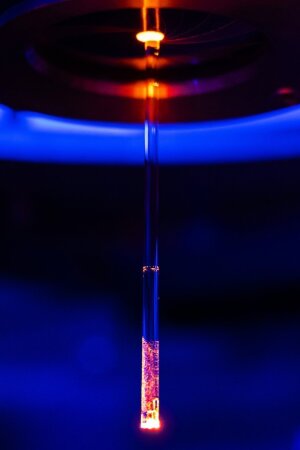
Optical fibres play a central role in modern data transmission and communication technologies. However, guiding light through glass fibres more than one kilometre long and less than one millimetre thick is by no means a new invention – even in ancient times, light was guided along the interfaces of media with different refractive indices. In this interview, physicist Prof. Dr Andreas Tünnermann discusses how technology from the past millennium could make data communication processes more secure and efficient in the future.
Interview by Ute Schönfelder
What role does glass play in today’s communication technologies?
A very important role. Practically all data is now transmitted via light signals. It wouldn’t be an exaggeration to say that the Internet as we know it would be unthinkable without communication with light and without the use of optical fibres to guide the light.
What are the advantages of transmitting data via light signals?
By using light as a signal carrier, we can achieve much higher transmission capacities than with other materials such as copper cables or by other means such as radio transmission. What’s more, data transmission via optical fibres is more energy efficient because optical fibres attenuate the signal much less than copper cables.
Energy efficiency has become an important issue in the field of information and communication technology, especially considering the immense increase in data volumes transferred worldwide each year. As the exchange of data continues to multiply through the use of streaming and cloud services, a significant amount of the global energy demand can now be attributed to the transfer and storage of data. So, we urgently need to reduce losses in transmission systems.
How is light conducted through an optical fibre?
What makes an optical fibre so special is the fact that light is guided in it via the mechanism of total reflection. A material with a high refractive index is surrounded by a material with a lower refractive index. The light propagates in the fibre and is almost completely reflected at the cladding interface, where it is guided back into the fibre. This protects it and prevents it from interacting with its surroundings.
This phenomenon has been known for thousands of years. Even in ancient times, people knew that light could be guided in a jet of water. In that case, water is the material with a high refractive index and the surrounding air is the material with a lower refractive index. The interesting thing is that you can guide light in any direction you want – even around corners. This is important for applications in communication, medical and production technology, where light is used to carry information and energy. Endoscope cameras are a prominent example here.
Cut glass rod beneath a hot fibre drawing furnace in a fibre drawing plant.
Image: Jens Meyer (University of Jena)What does optical fibre have to be like to optimally transmit light?
In general, the aim is to transmit light with as little loss as possible. In addition, optical fibres have to be doped with foreign atoms to set a refractive index profile that enables total reflection. Different glasses are used to produce optical fibres, the most important being silica glass: silicon dioxide (SiO2).
In the modern world, telecommunications fibres have been optimized to such an extent that they practically have no impurities and the attenuation of the signal in the fibres is almost entirely due to the material itself, the silica glass.
This allows data to be transmitted over several hundred kilometres without having to be amplified. This freedom from losses is also important in production technology, where light is used as a tool for cutting and welding, and where excessive attenuation could lead to the destruction of fibres.
What fibres are you and your teams working on at the University of Jena and Fraunhofer IOF?
Due to its material, traditional silica optical fibre has been exhausted in terms of its attenuation losses. So, if we want fibres with even lower propagation losses, we have to implement completely new principles for guiding light – and that’s exactly what we’re working on here. For example, we’re trying to guide the light signal in the fibre within tiny air tubes surrounded by a glass jacket. This is because the signal losses are lower when light propagates through air than when it propagates in glass. The mechanism used to guide light in these fibres is then no longer based on total reflection.
A second focus we are working on is laser fibres. So, we’re not only using optical fibres to transmit light, but also to generate light. Laser fibres aren’t the same as data fibres – they’re doped with rare earth metals such as neodymium or ytterbium, which amplifies the light.
To what extent do optical fibres also play a role in quantum communication?
The laser itself is a product of quantum physics. It’s based on the use of collective quantum phenomena. As we’re able to control individual quanta, including light particles (photons), we can now use quantum technologies to enable futuristic encryption methods and increase data security.
This is revolutionizing cryptography. By using specific quantum properties, we can generate »quantum keys« to encrypt data in a very secure manner. At the same time, we can even use specific protocols to ensure that not even the operator of the infrastructure is able to read the key. Both the data key and the data encrypted with it can be sent via optical fibres.
But when optical fibres are used in quantum communication, the attenuation losses have to be significantly reduced again, which is why we’re continuing our research into optical fibres with new light guidance mechanisms. Why is it so important to control losses in quantum communication? This is due to fundamental phenomena of quantum physics – unlike the classic transmission of light in optical fibres, the signal can’t simply be amplified. Quantum states can’t be cloned or restored.
